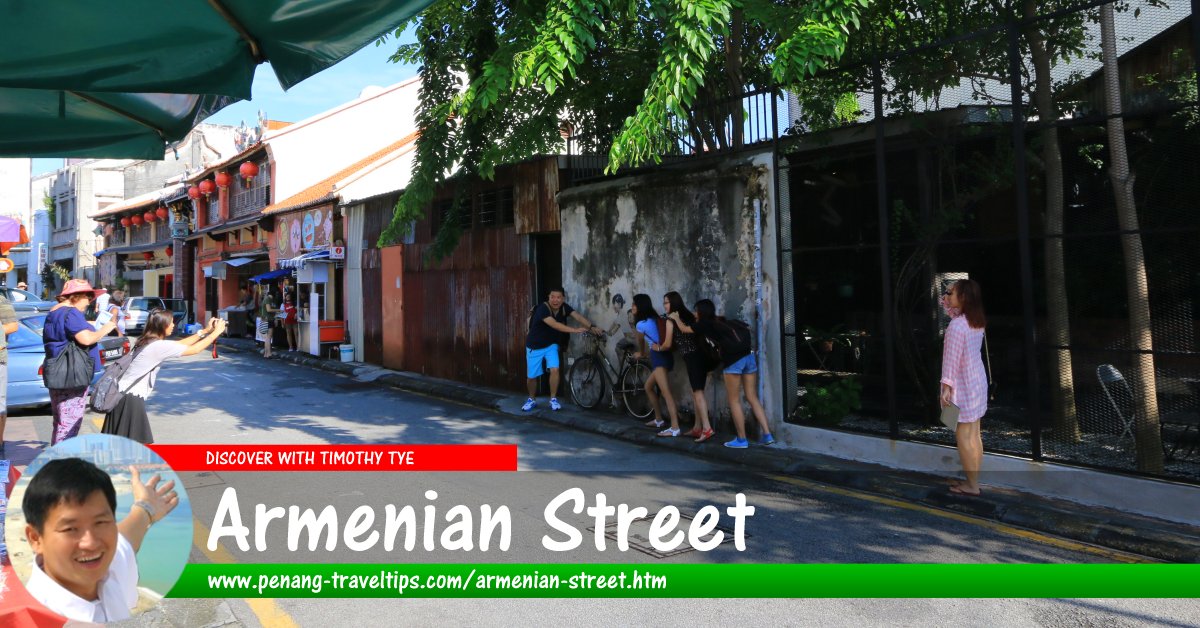 Tourists taking photos with Penang's most famous mural at Armenian Street. (4 December 2015)
Tourists taking photos with Penang's most famous mural at Armenian Street. (4 December 2015)
Lebuh Armenian, or Armenian Street, is a street in the inner city of George Town and within the core zone of the George Town Unesco World Heritage Site. It derives its name from an Armenian family who once stayed at the junction of the now Lebuh Armenian and Lebuh Pantai in the early part of the 19th century. The street is the venue of the weekly Armenian Street Fair.
 Map of Lebuh Armenian, Penang
Map of Lebuh Armenian, Penang
Accommodation on Armenian Street
- Armenian House (GPS: 5.41515, 100.33744)
- Armenian Suite (GPS: 5.41513, 100.33748)
- Straits Collection (GPS: 5.415722, 100.336482)
- Straits Heritage (GPS: 5.415752, 100.336736)
 Eateries along Armenian Street
Eateries along Armenian Street
- Ban Leong Ean (GPS: 5.415362, 100.337050)
- Edelweiss Cafe (GPS: 5.4151, 100.33779)

- Guan Seang Trading Cafe (GPS: 5.41453, 100.33819)
- Laviino Antique Cafe - closed (GPS: 5.41518, 100.33739)
- Le Café Chocolat (GPS: 5.41503, 100.33756)

 Sights along Armenian Street
Sights along Armenian Street
- Batik Painting Museum Penang (GPS: 5.41493, 100.33778)

- Cheah Kongsi (GPS: 5.4149, 100.33807)

- Choo Chay Keong Temple (GPS: 5.4154, 100.33689)

- Fuan Wong, The Gallery & Studio Howard (GPS: 5.41482, 100.33792)

- Galeri Seni Mutiara (GPS: 5.4158, 100.33622)

- Hock Teik Cheng Sin Temple (GPS: 5.41514, 100.33713)

- Sun Yat Sen Museum (GPS: 5.41578, 100.33617)

- Syed Alatas Mansion (GPS: 5.41578, 100.33617)

- Yap Kongsi (GPS: 5.41547, 100.33679)

Street Art on Armenian Street
- "Little Children on a Bicycle" Mural (GPS: 5.41463, 100.33824)

- "Too Narrow" Sculpture (GPS: 5.41534, 100.33758)

- "Procession" Sculpture (GPS: 5.41534, 100.33732)

- "This Old Man" Mural (GPS: 5.41543, 100.33717)

- "Then & Now" Sculpture (GPS: 5.4157, 100.33649)

 Businesses on Armenian Street
Businesses on Armenian Street
- Chai Tiam Ma Souvenir Shop (GPS: 5.41476, 100.33817)
- Bon Ton The Shop (GPS: 5.4157, 100.3368)
- China Joes (GPS: 5.41563, 100.33689)
- Fuan Wong The Gallery (GPS: 5.41473, 100.33805)
- Jonathan Yun Sculptural Jewelry (GPS: 5.41473, 100.33805)
- Keng Fatt Sdn Bhd (GPS: 5.41507, 100.33757)
- Lao Jie Fang Souvenir Shop (GPS: 5.4148, 100.33797)
- Nyonya Beaded Shoes (GPS: 5.41481, 100.33812)
- Red Pinang Culture House Souvenir Shop (GPS: 5.41503, 100.33785)
- Summer Lane Venture (GPS: 5.41529, 100.33742)
- Willemina Handmade Jewellery (GPS: 5.4149, 100.33782)
 Souvenir shop on Armenian Street, George Town (4 December 2015)
Souvenir shop on Armenian Street, George Town (4 December 2015)
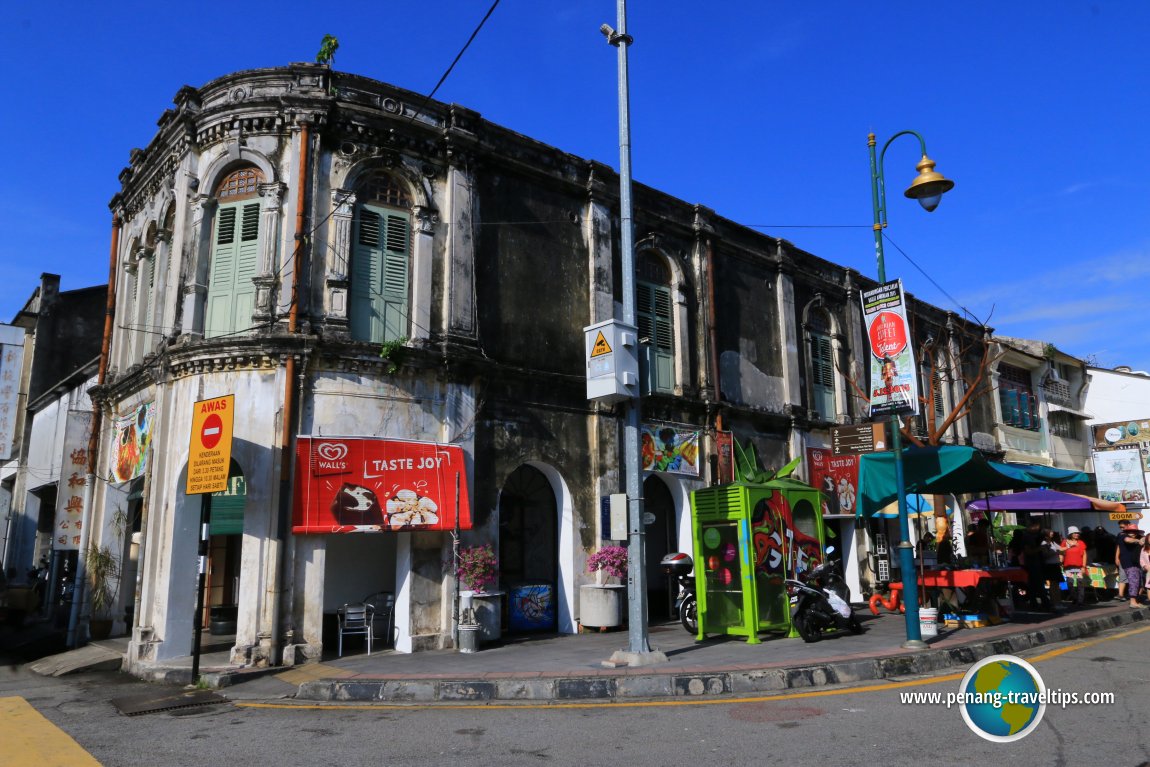 266 Lebuh Pantai, the circa 1907 building at the junction of Armenian and Beach Streets (4 December 2015)
266 Lebuh Pantai, the circa 1907 building at the junction of Armenian and Beach Streets (4 December 2015)
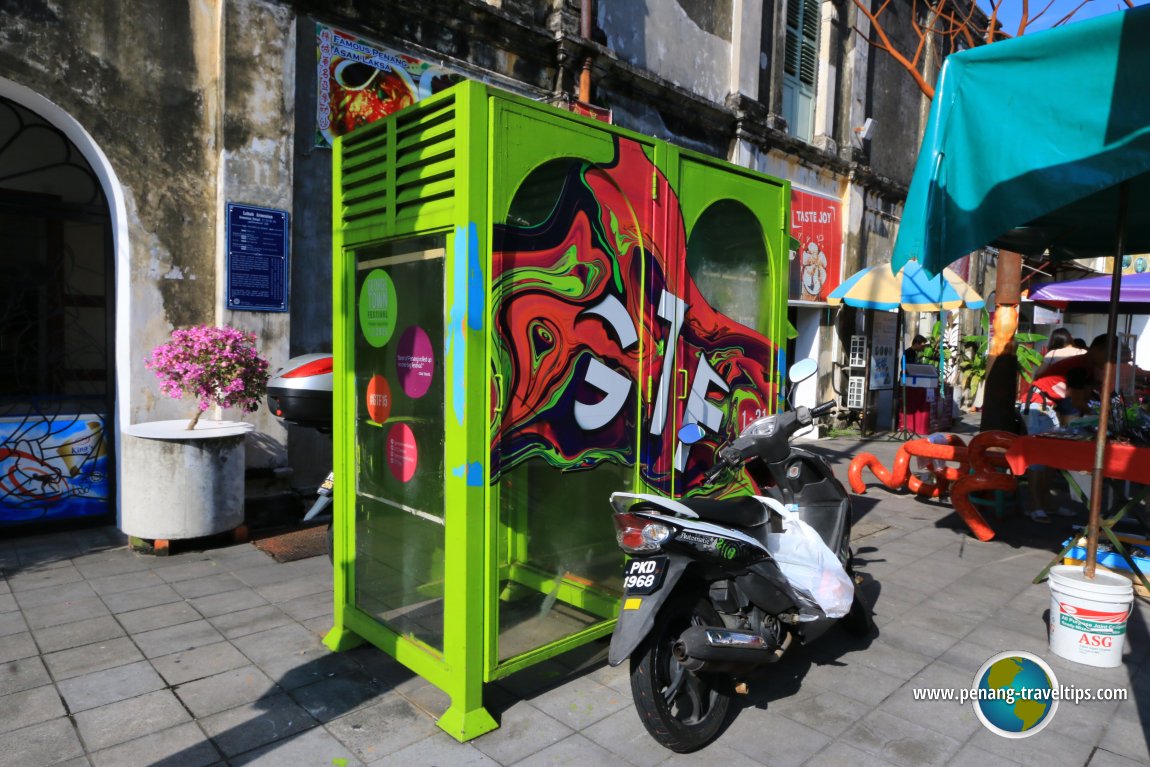 Armenian Street phone booth (4 December 2015)
Armenian Street phone booth (4 December 2015)
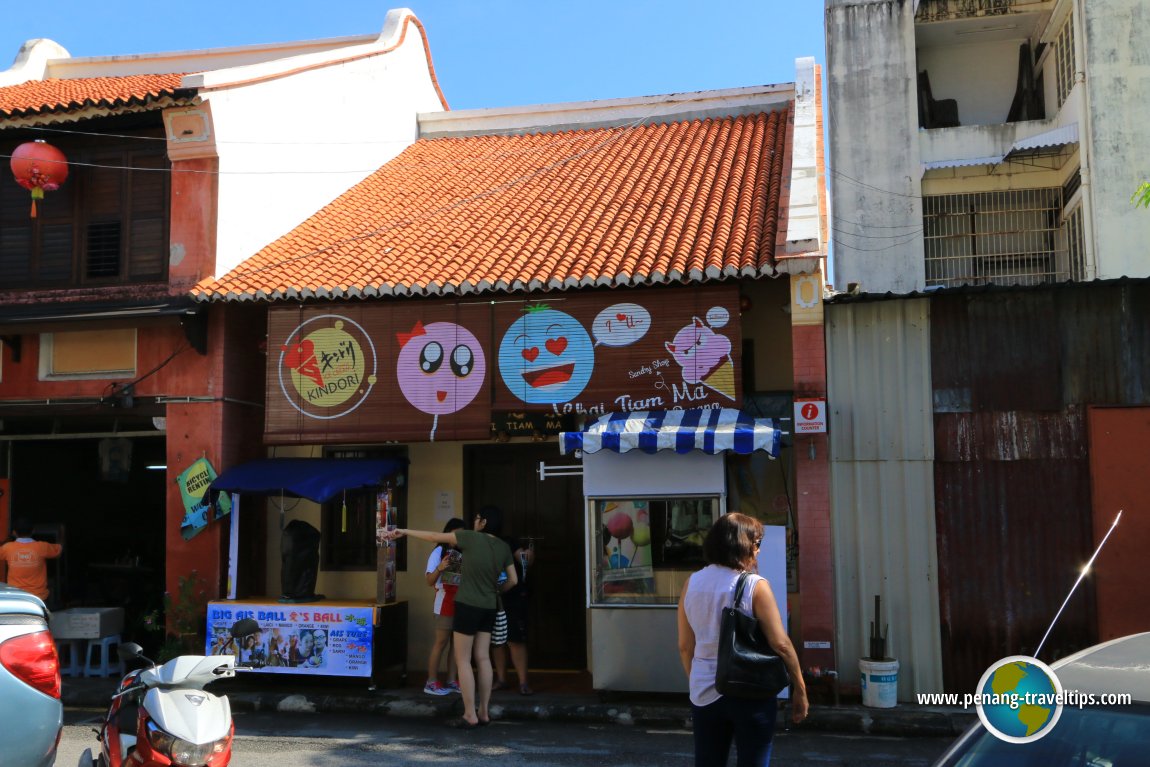 Chai Tiam Ma specialty shop at Armenian Street (4 December 2015)
Chai Tiam Ma specialty shop at Armenian Street (4 December 2015)
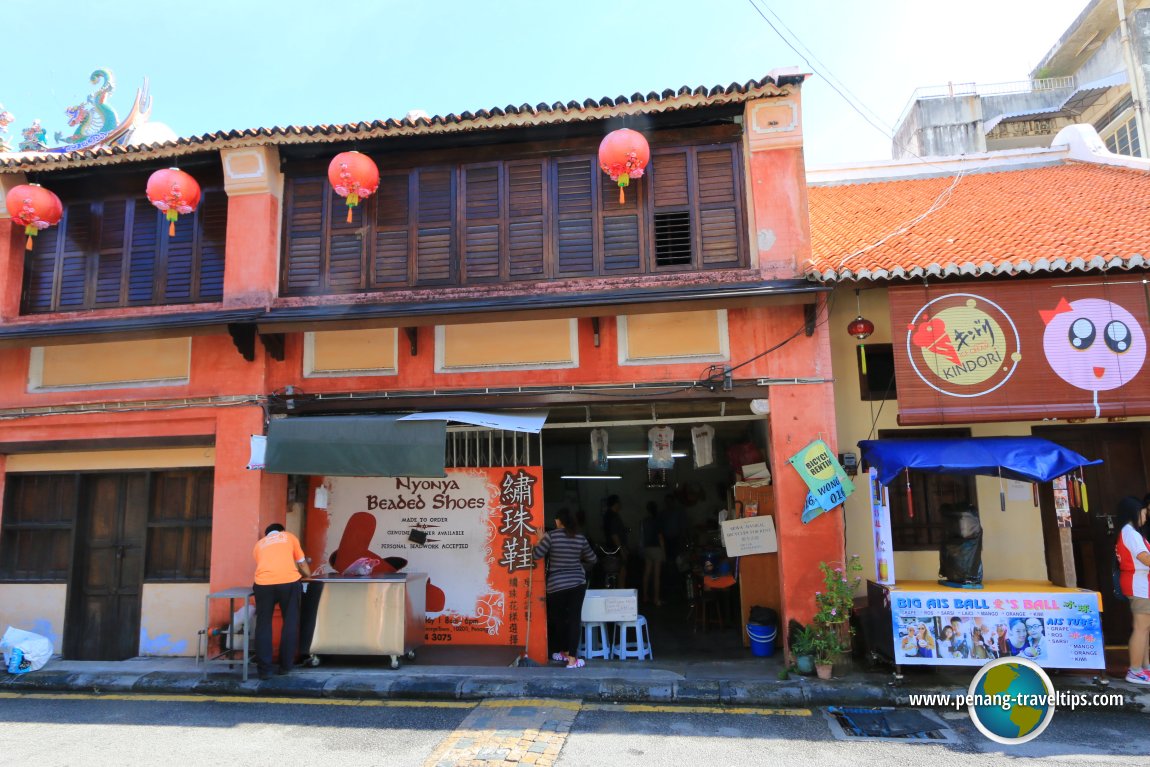 Nyonya Beaded Shoes at Armenian Street (4 December 2015)
Nyonya Beaded Shoes at Armenian Street (4 December 2015)
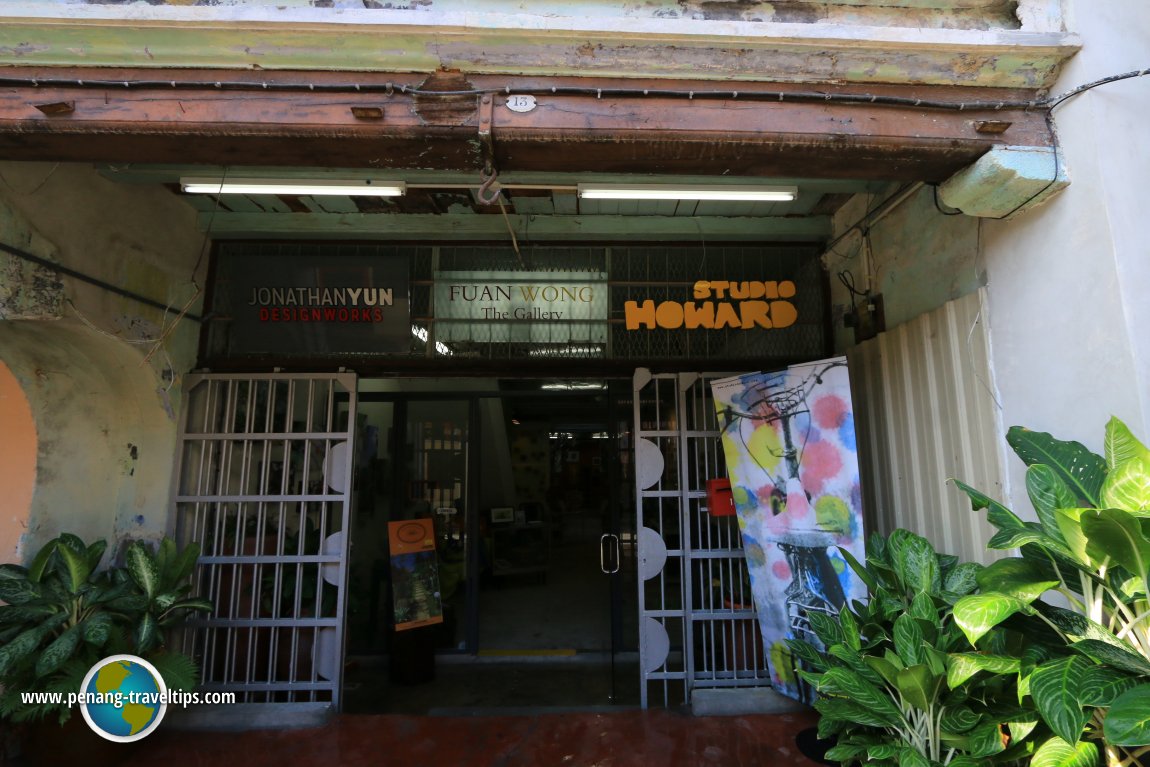 Jonathan Yun Designworks, Fuan Wong Gallery & Studio Howard (4 December 2015)
Jonathan Yun Designworks, Fuan Wong Gallery & Studio Howard (4 December 2015)
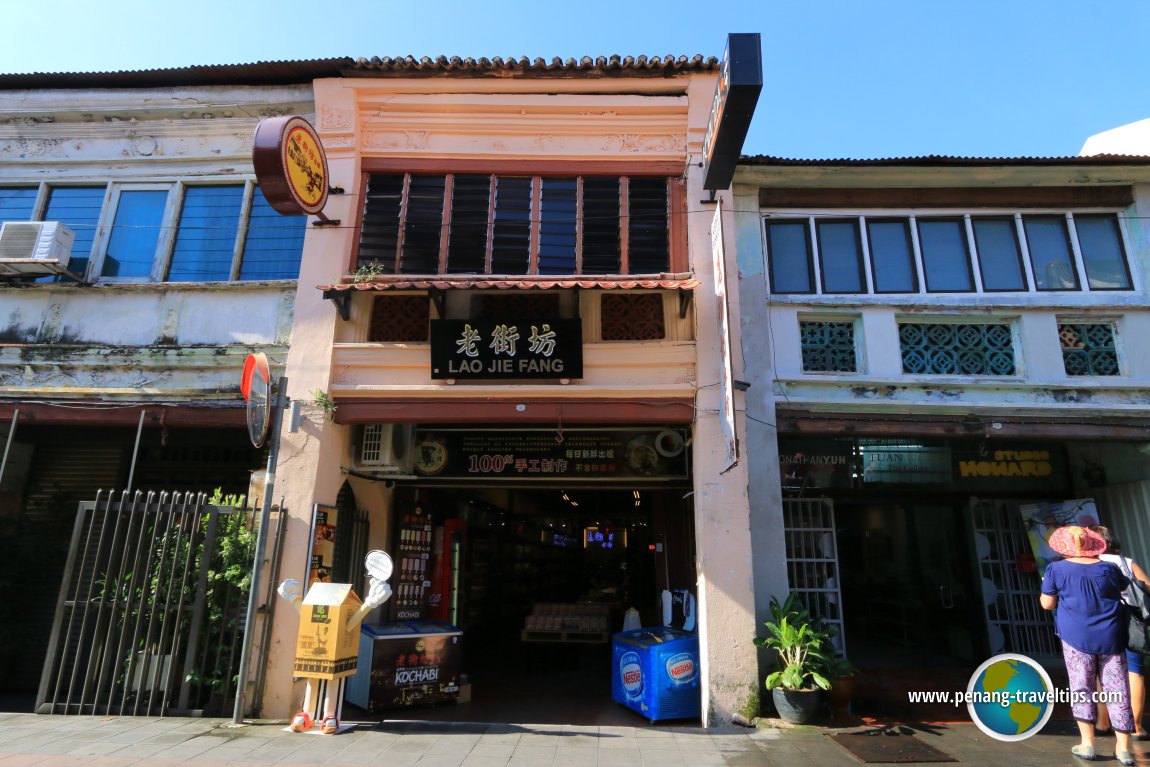 Lao Jie Fang Souvenir Shop (4 December 2015)
Lao Jie Fang Souvenir Shop (4 December 2015)
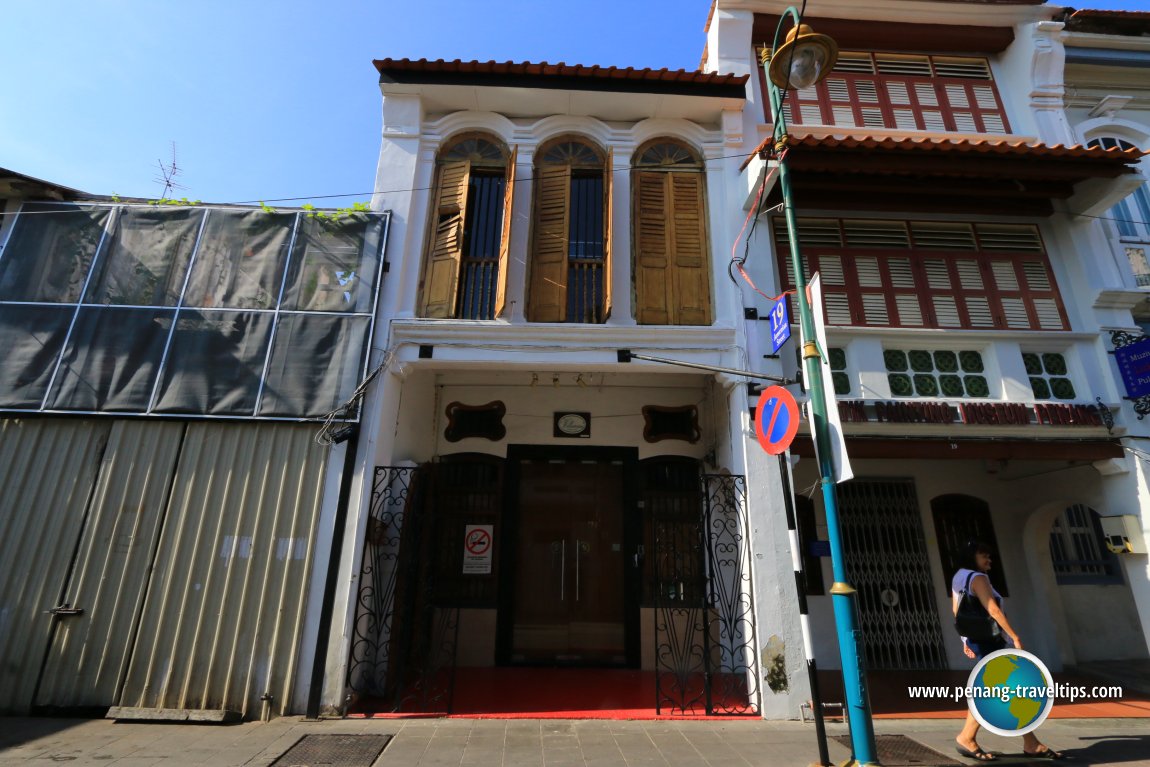 Willemina Handmade Jewellery (4 December 2015)
Willemina Handmade Jewellery (4 December 2015)
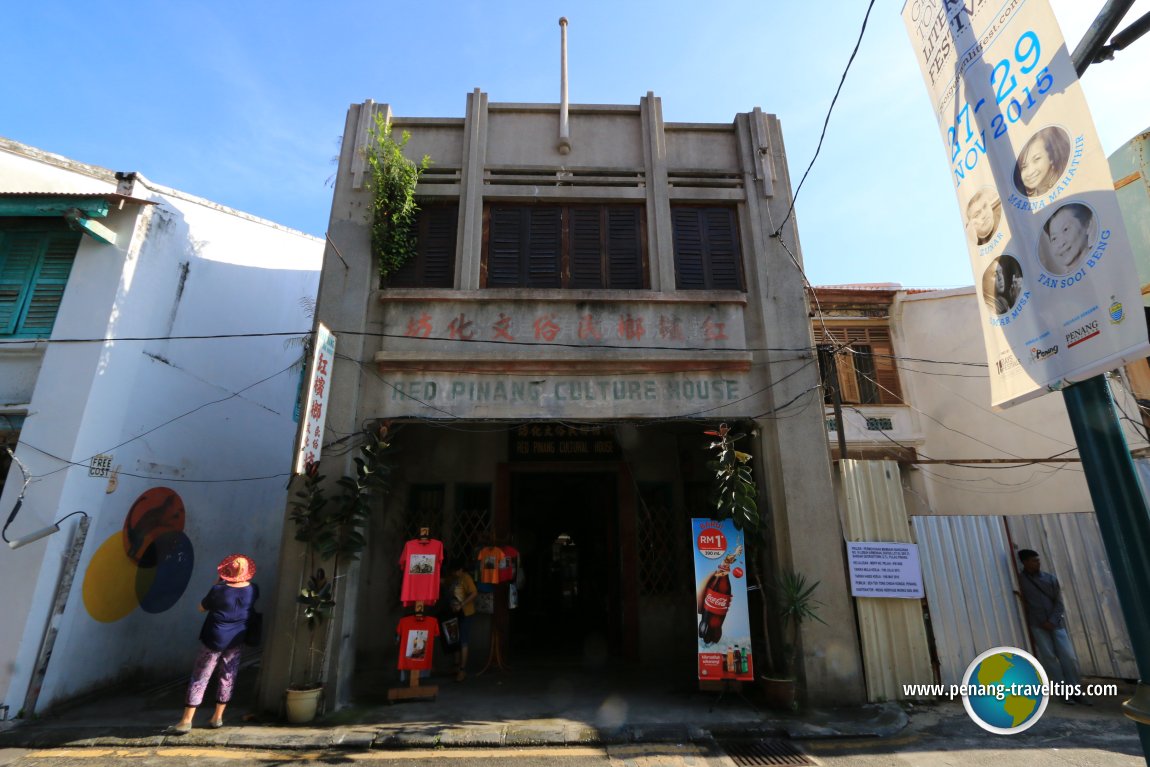 Red Pinang Culture House (4 December 2015)
Red Pinang Culture House (4 December 2015)
Armenian Street Fair
The Armenian Street Fair is a weekly street fair taking place along a stretch of Armenian Street between the intersection of Pitt and Cannon Streets to the west and Beach Street to the east. The fair is held every Saturday evening. It is the venue for local talents to showcase their crafts and street performances.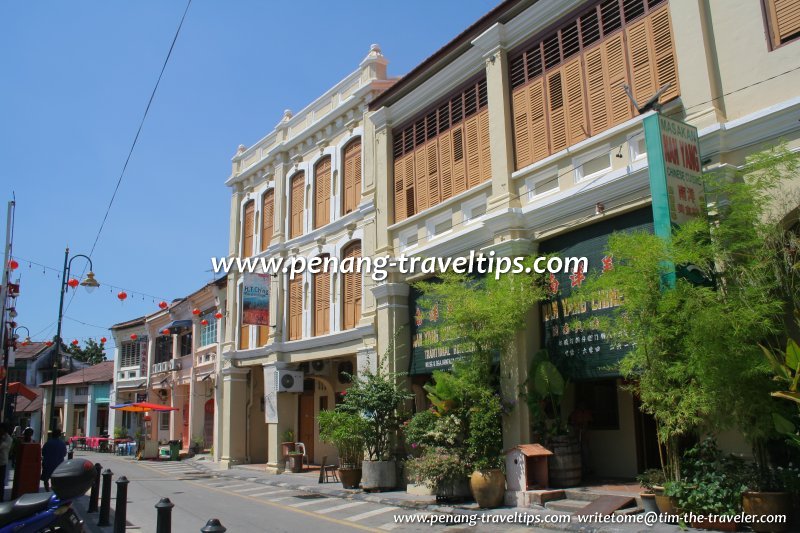 Armenian Street, George Town, Penang (24 February 2007)
Armenian Street, George Town, Penang (24 February 2007)
History of Armenian Street
Armenians arrived in Penang by way of India. By 1822, they had established their church, the Armenian Church of St Gregory, which was located where Bangunan Mayban Trust is standing today. It was some eleven years older than the Armenian Church of St Gregory in Singapore. However the church was demolished around 1937, by which time most of the Armenians had packed up and left Penang.In the earlier days, Armenian Street was known as Malay Lane. This was how it was labelled on the 1803 map of Governor George Leith1, based on the Malay and Achehese presence in the area that predates the shortlived stay of the Armenians on that street. The Malay settlement continues to this day with such monuments as the Acheen Street Mosque and Penang Islamic Museum in that vicinity. On the other hand, the name Armenian Street first appeared on the 1807 map1.
Armenian Street developed its Chinese appearance as Chinese traders moved into the area from the turn of the 20th century. Clan temples such as Cheah Kongsi, Yap Kongsi and Khoo Kongsi were established either on or within a stone's throw of Lebuh Armenian. Traders and merchants of these clans helped to finance the mining of tin in the Larut district of Perak, which resulted in much prosperity flowing into the Lebuh Armenian area from the 1860s right through to the early 20th century.
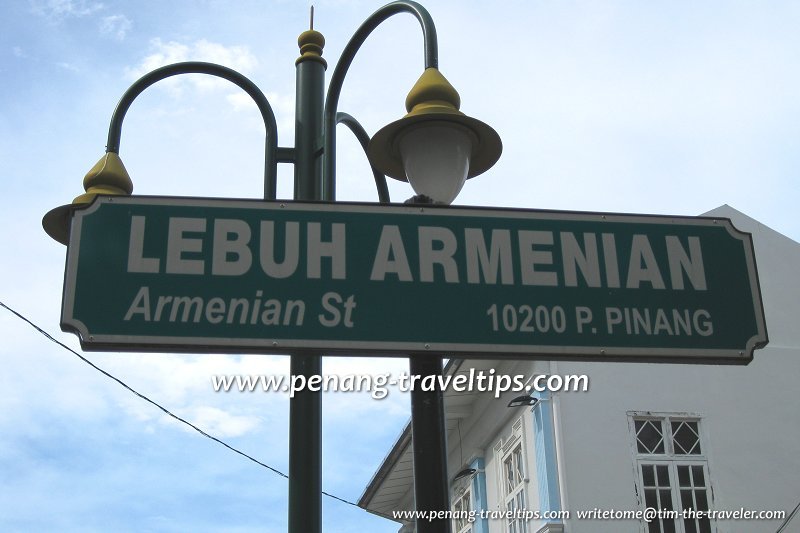
Armenian Street sign (12 November 2008)

In Other Words ...
Armenian Street is known in Hokkien as Phak1 Tang3nga1 Kay1 (打銅仔街 Pinyin: Pāi Tóng Jiē) meaning "coppersmith street" from the junction with Acheen Street to the junction with Cannon Street. It is known as 本頭公巷 (Pun1 Thau3 Kong3 Hang33
(打銅仔街 Pinyin: Pāi Tóng Jiē) meaning "coppersmith street" from the junction with Acheen Street to the junction with Cannon Street. It is known as 本頭公巷 (Pun1 Thau3 Kong3 Hang33  ) between Cannon Street and Beach Street.
) between Cannon Street and Beach Street.
House Numbering
The address on Armenian Street descends from east to west starting from Beach Street, with housing on the left having odd numbers and those on the right even.Properties on Armenian Street
The following are details of some the buildings on Armenian Street, with photo illustrations.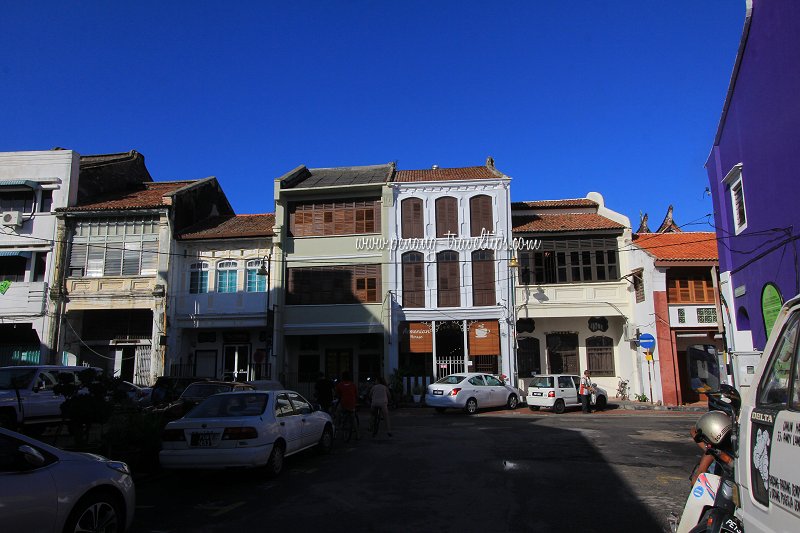 From left to right: 29, 31, 33, 35 and 37 Armenian Street (30 June 2014)
From left to right: 29, 31, 33, 35 and 37 Armenian Street (30 June 2014)
This photograph, taken over a year after the one below it, shows House No. 29 and 31 on the left. No. 29 Armenian Street is taller than No. 31. Both of them were built in the late 19th century. However, while No. 29 has replaced its windows with louvres, No. 31 still bear the original Straits Eclectic-style window frames, albeit the original wooden panels having been replaced with glass.
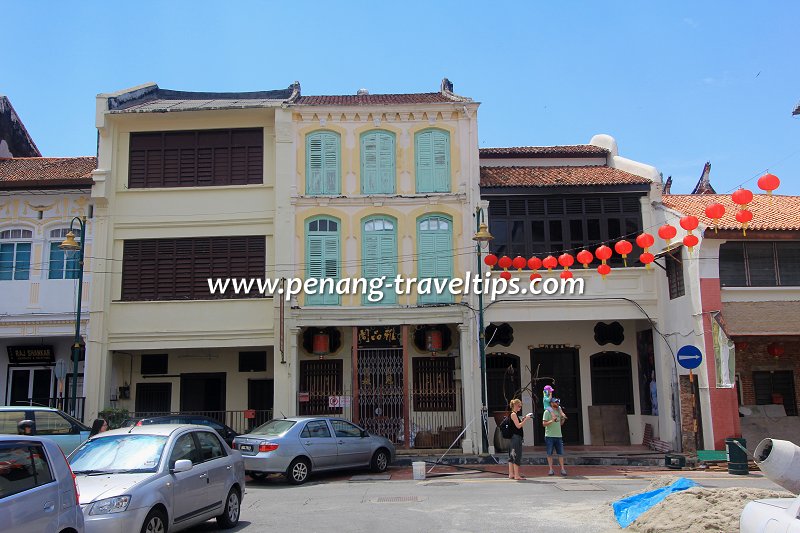 33, 35 & 37 Armenian Street (25 January 2013)
33, 35 & 37 Armenian Street (25 January 2013)
The three shophouses in the photograph about dates from the late 19th century. All have undergone some degree of restoration. No. 33, on the left, is a 3-storey shophouse with a rather plain façade. No. 35, at centre, retains its French windows with wooden shutters. No. 37, at right, is a restored two-storey shophouse, with a porch in lieu of a five-foot way.
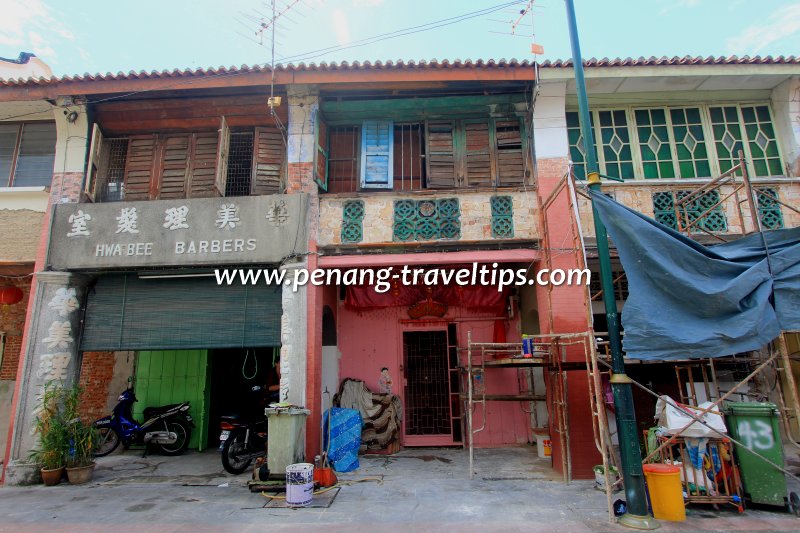 39-55 Armenian Street (25 January 2013)
39-55 Armenian Street (25 January 2013)
This row of shophouses, near the intersection with Pitt and Cannon streets, are two storeys tall. They were undergoing restoration when I photographed them in January, 2013. This ensemble is part of the Hock Teik Cheng Sin complex, serving as the front and buffer to the temple located behind them. They were built in the mid-19th century, after then Thean Teik Tong (precursor of Hock Teik Cheng Sin) was established. They are rather simple in style, though one interesting feature is the green ceramic vents at the spandrels that survive till today.
 39 Armenian Street (30 June 2014)
39 Armenian Street (30 June 2014)
Here's No. 39 Armenian Street a year and a half later. By now (30 June 2014), it has been fully restored. The front porch has a whitewashed wall with a plain wooden door flanked by two equally plain wooden windows with grill bars, and topped with bat-shaped air-vents. The floor, previously cement, is now of terracotta tiles.
Street Art
Armenian Street has three pieces of street art. They include two murals by Ernest Zacharevic and two steel-rod sculptures based on caricatures by Tang Mun Kian. I call the murals "Little Children on a Bicycle" and "This Old Man", while the sculptures are called "Procession" and "Then & Now".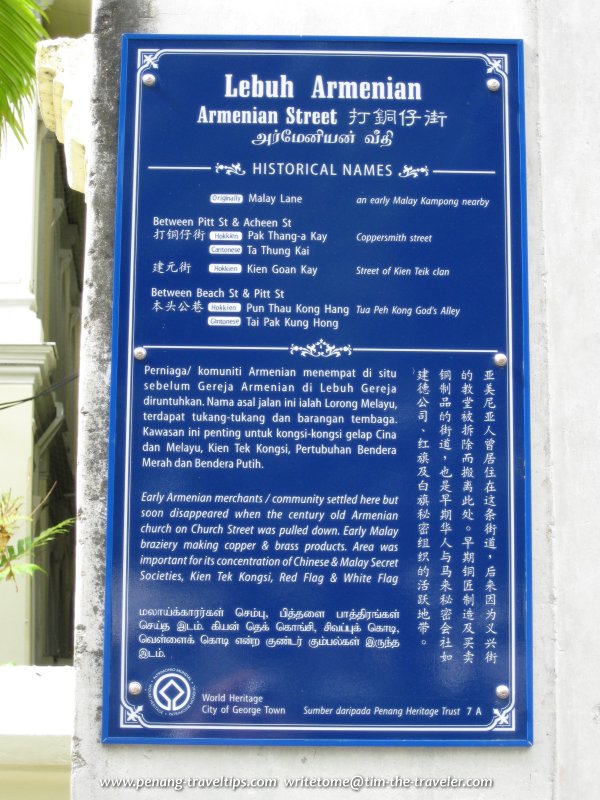
Armenian Street plaque (12 November 2008)

Getting there
From Weld Quay Ferry & Bus Terminal, turn left and walk along Pengkalan Weld until you reach the junction of Gat Lebuh Armenian (Armenian Street Ghaut) to your right. Enter Gat Lebuh Armenian and follow it all the way until the junction of Lebuh Pantai. Armenian Street (Lebuh Armenian) is located across Lebuh Pantai.References
- Heritage Buildings of Penang Island: George Town, published by the Building Department & the Planning Department, Municipal Council of Penang Island (MPPP, 1994)
List of Streets in Penang and Streets in Malaysia

Copyright © 2003-2025 Timothy Tye. All Rights Reserved.

 Go Back
Go Back